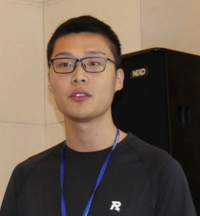B.Eng and M.Phil, HKUST





Ms. Jiang has be at the helm of Desay Automation Technology since 2007; shaping the company's successful smart factory and automotive technologies units. Expert in strategic positioning in the Great Bay's ecosystem, Ms. Jiang launched Desay into top automotive supply chain for Benz, Audi, BMW, etc. She is an advisor to many government units and have built countless international collaborations.

Ms. Jiang has be at the helm of Desay Automation Technology since 2007; shaping the company's successful smart factory and automotive technologies units. Expert in strategic positioning in the Great Bay's ecosystem, Ms. Jiang launched Desay into top automotive supply chain for Benz, Audi, BMW, etc. She is an advisor to many government units and have built countless international collaborations.
Co-organised by HKU and HKSTP, the week-long hackathon is targeting students from Stanford University & Hong Kong universities, and young professionals from HKSTP to experience Stanford Biodesign methodologies, design thinking, business model canvas, and to work in interdisciplinary teams to come up with prototypes of sustainable healthcare solutions.
The Final Pitch was held at HKSTP@Wheelock on 29 June 2019, the winning teams are as follow:
Mashiat LAMISA and Xuelai WEI [BSc in ISD] with their team
– A way to reduce possibilities of influenza outbreak among nursing home staff and visitors by improving effectiveness in routine hand hygiene practices
Mashiat LAMISA [BSc in ISD] with two UBC team members
Division of Integrative Systems and Design undergraduate student Mashiat Lamisa, who is currently on exchange at the University of British Columbia (UBC), received a prize at Vancouver’s first and largest all-female* hackathon “cmd-f”, which was held at UBC on the International Women’s Day weekend (Mar 7-8, 2020).
Organized for the second year, the 24-hour hackathon attracted 278 female* hackers in 70 teams. Mashiat and her two UBC team members (Dama Correch, undergraduate student in cognitive science, and Ilana Zimmerman, master’s student in computational linguistics) created the Know Your Rights app and won the Empower Women Through Technology Prize sponsored by the company SAP. Their app is one of the 12 winning projects among the 61 project submissions.
Leveraging the power of crowdsourcing, their app empowers women and other gender minorities to know their rights when dealing with gender wage gaps, harassment, and other problems in the workplace. The user first fills out a form and summarizes their experience. The app will then display recommendations, the Canadian law being violated, next steps, and resources available. Additionally, the output displays a similar past user experience and the resolution experienced along with a similarity score comparing the two experiences.
“One of the best highlights of coming to exchange in a very STEM-based university like UBC has been joining this all-female* hackathon where I got to meet many supportive and like-minded women from diverse backgrounds and countries to develop something impactful. It makes me realize more that the goal of any engineering student in the world is to develop things that creates ripples in existing systems,” said Mashiat.
“This experience has boosted my confidence in tech as a woman, giving me more reason to hack again in the future,” she added.
Related link: cmd-f 2020
* Remarks from organizers: The cmd-f team would like to acknowledge that “female” or “women” is not an accurate description for many people and it may make some feel unwelcome. * is used to specifically and intentionally include cis and trans women, as well as non-binary, agender and intersex people.
Team Name: Horizon Biochip
Primary Area: Healthcare
Brief Description: Horizon Biochip focuses on applying biochip technologies to different biotechnological applications. Its product CryoChip automates the process of preserving embryos/oocytes in IVF medical procedure
The School of Business and Management of The Hong Kong University of Science and Technology (HKUST Business School) joined hands with China Everbright Bank Hong Kong Branch (CEBHK) to organize the bank’s first academic-industry collaborated cyber security competition for students.
Amid the growing threats of cyber attacks, the competition “Cyber Defenders Challenge – Team Up for the Good Fight”aimed to promote cyber security awareness and provide an opportunity for students at HKUST to address some real-world threats faced by information security experts.
The full-day event was held at HKUST on May 10, where IT experts from CEBHK were invited to provide training and share their real-life experiences in protecting their customers from hackers and compliance of best practices. Cybersecurity company Fortinet provided technical support for the competition.
Officiated at the kick-off ceremony, Prof. TAM Kar-Yan, Dean of the HKUST Business School, said, “Our School not only seeks to develop talent who are capable of supporting the city’s economic and social development, but also assist in addressing the new challenges that confront corporations in today’s digital economy. Thanks to the exceptional opportunity provided by CEBHK, our students were able to learn a different facet of problems faced by corporations - cyber risks.”
Mr Desmond Wu, Chief Risk Officer and Managing Director of China Everbright Bank, Hong Kong Branch, and Vice President of The Hong Kong Institute of Bankers, said, “The Hong Kong University of Science and Technology (HKUST) is a world-class university with first-class technology disciplines and top research institutions. CEBHK is delighted to collaborate with HKUST to carry out financial technology innovation cooperation and initiatives, to build a financial technology ecosystem integrating ‘production, study and research’, to promote the construction of a financial technology incubation platform, and to cultivate practical financial technology talents.”
The 20 two-member teams, recruited from across the University, were tasked to defend against a series of complex cyber and email attacks in a computer-simulated environment. The top three teams were rewarded with fabulous prizes and internship opportunities provided by CEBHK.
About China Everbright Bank Hong Kong Branch
China Everbright Bank Hong Kong Branch (hereafter referred to as “CEBHK”) was founded in February 2013 and is a full licensed bank in Hong Kong. Headquartered in Beijing, China Everbright Bank was ranked 39th in the “Top 1000 World Banks” by the U.K. magazine The Banker in 2018. Leveraging on the strong capital positions and the extensive clienteles of China Everbright Group and China Everbright Bank, CEBHK base in the international financial market of Hong Kong, focusing on the wholesale banking business. CEBHK provide various services including corporate financing, syndicated loan, debt capital market products, FX products, interest rate products, trade finance, RMB services, etc. CEBHK also actively promote the cross-border business and offer full range of customized financial solutions.
HKUST Business School
Founded in 1991, the HKUST Business School is young, innovative and committed to advancing global business knowledge. The School has forged an international reputation for world class education programs and research performance, and has received many top global rankings. It is one of the first Asian business schools accredited by both AACSB and EQUIS. The School strives to contribute to the economic and social advancement of the region by developing future leaders who possess an innovative and entrepreneurial spirit as well as a strong sense of responsibility. We also take active steps to promote knowledge advancement in many significant business areas. For more information, please visit www.bm.ust.hk.